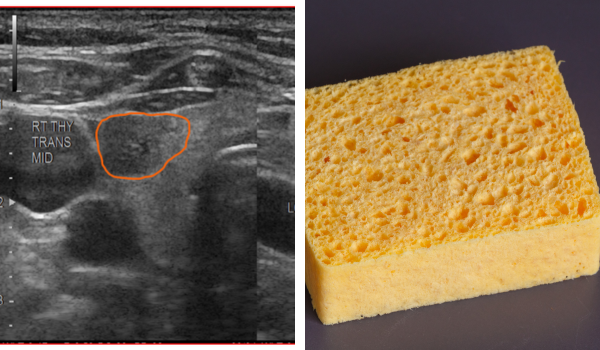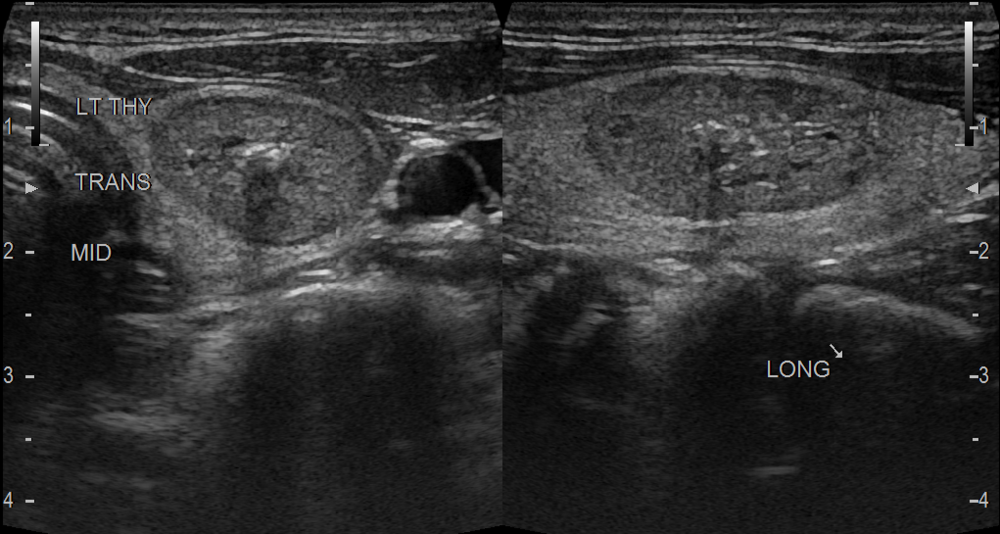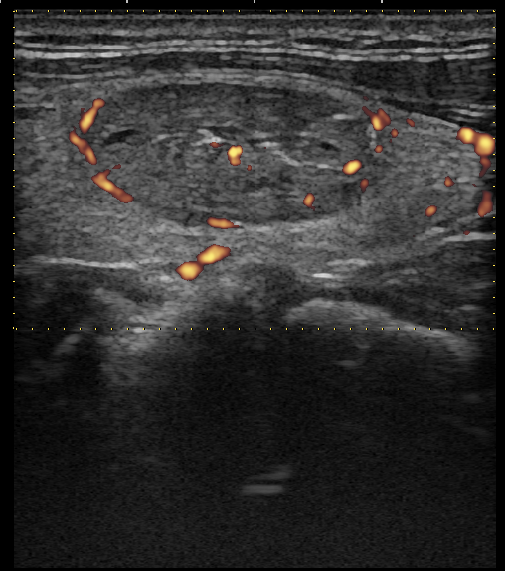Spongiform Thyroid Nodules: Top 4 Things to Know

Introduction
Thyroid nodules are abnormal growths that occur in the thyroid gland forming a lump or bump within the otherwise smooth thyroid surface. Thyroid nodules are common, occurring in 40% of women and 30% of men during their lifetime. Spongiform thyroid nodules are very common. Similar to all thyroid nodules, most spongiform thyroid nodules are benign. When people hear they have a spongiform thyroid nodule they worry about cancer and the need for surgery. Below are the top 4 things to know about spongiform thyroid nodules.
Spongiform Thyroid Nodules: Top 4 Things to Know
#1 Things to Know About Spongiform Thyroid Nodule: Most are benign
Like the vast majority of thyroid nodules, spongiform thyroid nodules are very frequently benign. They got this name and description because the appearance of these nodules on ultrasound is similar to that of a sponge. As seen in the images below, these spongiform thyroid nodules look soft and porous on ultrasound with a slightly uneven texture (heterogeneous). The borders are well-defined and clear.
As seen below, not all spongiform thyroid nodules are benign. Some have suspicious features that warrant a needle biopsy (fine needle aspiration or FNA). Fewer are cancerous or large enough to require surgery.
Below is an ultrasound images of benign spongiform nodule (pictured next to a sponge so you can see how it gets its name!)

#2 Thing to Know About Spongiform Thyroid Nodules: Size matters
Like all thyroid nodules, the size of a spongiform nodule is important. While size is certainly not the only criterion to consider when making a clinical decision about needle biopsy, surveillance, or thyroid surgery, it certainly cannot be ignored. As thyroid nodule size increases, the need for surgery does as well. When not considering other parameters such thyroid cancer, thyroid function, etc., the size of a nodule can reliably predict the need for surgery. Spongiform nodules that are 4 cm or larger need to be removed with an expert thyroid surgery. Very large nodules rarely need to be biopsied because surgery is indicated to remove these lesions based on thyroid nodule size alone. Either way, almost all large spongiform thyroid nodules will eventually need surgery.
As these nodules get bigger, they can cause symptoms and the needle biopsies are less reliable (due to the increasing volume that cannot be completely sampled with a tiny needle). Eventually, the nodules often will cause symptoms such as difficulty swallowing or breathing, a noticeable bulge or mass in the neck, pressure/discomfort (particularly when lying down), and a feeling of a lump or something stuck in one’s throat. Additionally, as these nodules grow, they can extend into the chest cavity, or push on the windpipe (trachea) or swallowing tube (esophagus), or grow behind the voice box. It is important to note, however, that thyroid nodule size does not directly correlate with the nodules being malignant, especially in the case of spongiform nodules. While the risk for cancer and spread to lymph nodes increased with large nodules (10.4%- 22%), not all big thyroid nodules are cancerous.
#3 Thing to Know About Spongiform Thyroid Nodules: Nodules in the isthmus are more concerning
The isthmus is the small strip or middle portion of the thyroid that connect the two lobes or halves (Image 3). This portion of the gland is thin and sits directly on the wind pipe (trachea). Similar to size, the location of a spongiform thyroid nodule is important to consider. Thyroid nodules in certain locations (i.e. deeper back toward the esophagus and spine) tend to be symptomatic more frequently. Similarly, in our vast experience, spongiform thyroid nodules located in the isthmus of the thyroid lobe are more suspicious and symptomatic more frequently.
The isthmus is not an ideal location for a cancerous spongiform nodule. That is because there is very little tissue separating the cancer from the trachea and the muscle, tissue, and skin overlying the cancerous nodule. As such, these cancers can extend or grow outside of the confines of the thyroid gland sooner than thyroid cancers elsewhere. All of this is to say, the threshold for needle biopsy and surgery should be lower for spongiform thyroid nodules in the isthmus.
.jpeg)
#4 Thing to Know About Spongiform Thyroid Nodules: They can have suspicious features
While most spongiform thyroid nodules by far and away are benign, a small percentage have suspicious features and can be cancerous. Nodules that have increased blood flow relative to surrounding thyroid tissue (hypervascular), contain microcalcifications, are hypoechoic (darker than surrounding thyroid tissue), are taller rather than wide, and/or have ill-defined or irregular borders are certainly concerning. Suspicious spongiform nodules with any of the aforementioned characteristics warrant a needle biopsy and/or thyroid surgery. In most cases, larger spongiform nodules with suspicious features should be removed with thyroid surgery.
The below are ultrasound images of a suspicious spongiform thyroid nodule, showing signs of calcification. The second image shows increased blood flow.


Spongiform thyroid nodules: Summary
Thyroid nodules are very common. They are abnormal growths that occur in the thyroid gland forming a lump or bump within the otherwise smooth thyroid surface. Spongiform thyroid nodules are extremely common. While a very high percentage of spongiform thyroid nodules are benign, a small percentage are cancerous, large, located in the isthmus, and/or contain suspicious features. In these instances, expert surgical evaluation and treatment is imperative to ensure excellent outcomes and avoid complications.
Our team of thyroid cancer experts is here to help and guide you every step along the way and will be there for you after your thyroid nodule surgery. The Clayman Thyroid Center is dedicated to providing world-class care for thyroid cancer and thyroid disease. To learn more and become a patient, please see our resources below.
Additional Resources
- Become our patient by filling out the form at this link.
- Learn more about The Clayman Thyroid Center here.
- Learn more about our sister surgeons at the Scarless Thyroid Surgery Center, Norman Parathyroid Center, and Carling Adrenal Center
- Learn more about the Hospital for Endocrine Surgery.